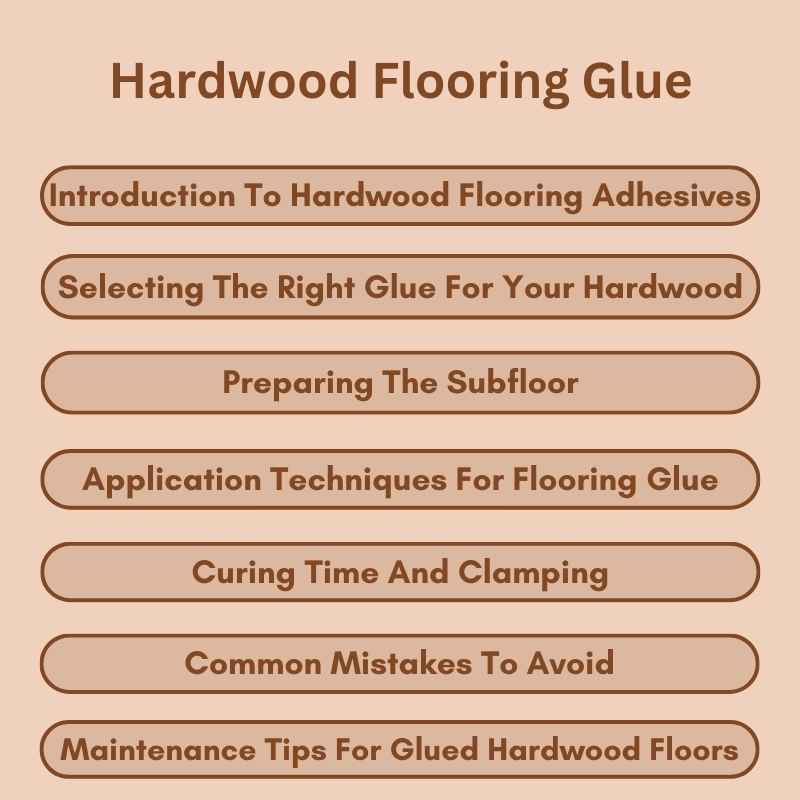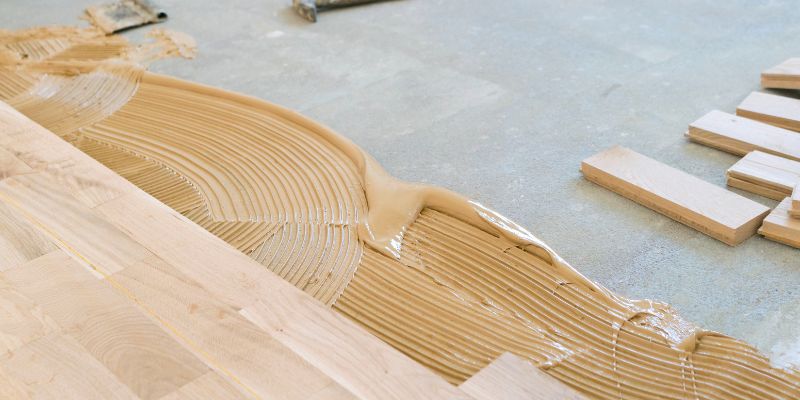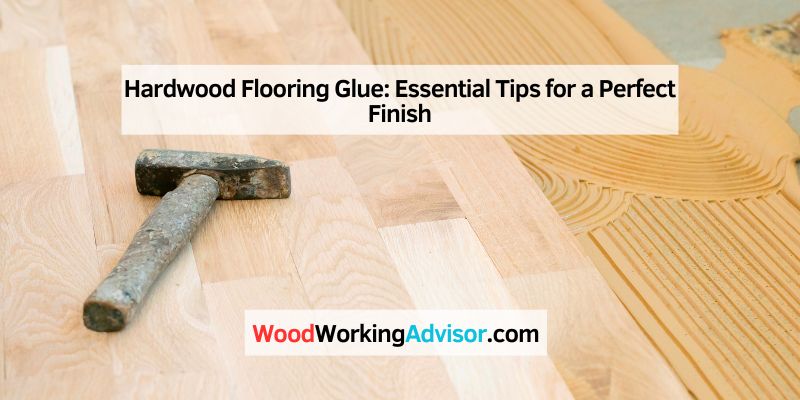Hardwood flooring glue is an adhesive specifically designed for securing hardwood planks to subfloors. This glue ensures a strong bond, preventing movement and warping.
Choosing the right hardwood flooring glue is crucial for a successful installation. It plays a significant role in the durability and stability of your flooring. Various types of adhesives are available, each suited for different hardwood species and installation methods.
Water-based, urethane, and epoxy options offer unique benefits. Understanding these differences helps ensure that you select the right product for your needs. A proper adhesive not only enhances the aesthetic appeal but also contributes to the longevity of your floors. Investing time in research will yield better results and satisfaction with your flooring project.
Introduction To Hardwood Flooring Adhesives
Choosing the right hardwood flooring glue is essential for a strong bond. Different types of adhesives are available for various needs. Below are some common types:
| Type of Adhesive | Description |
|---|---|
| Water-Based Glue | Easy to clean and low odor. Ideal for indoor use. |
| Urethane Glue | Offers strong bonding and moisture resistance. Great for all hardwood types. |
| Polyurethane Glue | Expands as it dries, filling gaps. Very durable and waterproof. |
Using the right adhesive has many benefits. It ensures a long-lasting floor. A good bond prevents gaps and squeaks. Proper adhesion protects against moisture damage. This can save on future repair costs.

Selecting The Right Glue For Your Hardwood
Choosing the right glue for hardwood flooring is crucial. Consider the type of wood you have. Different woods require specific adhesives for better bonding.
Humidity and temperature also play important roles. Some glues work better in certain conditions. Check the manufacturer’s recommendations for best results.
Glue offers several advantages over other installation methods. It can create a strong bond. This bond helps prevent shifting and creaking.
Using glue can be faster and cleaner than nails. It eliminates the need for visible fasteners. This leads to a smoother, more attractive finish.
Preparing The Subfloor
Start by cleaning the subfloor thoroughly. Remove any dust, dirt, or debris. Use a vacuum or broom for best results. Ensure the surface is dry before proceeding.
Next, check for levelness. Use a level tool to find any uneven spots. Fill low areas with a suitable leveling compound. This will help the hardwood flooring fit perfectly.
Conduct a moisture test to ensure the subfloor is dry. Use a moisture meter to check levels. Ideal moisture content should be below 12% for plywood. For concrete, it should be less than 4%. This step is crucial to prevent future issues.
Application Techniques For Flooring Glue
To apply hardwood flooring glue, several tools and materials are essential. Use a notched trowel for spreading glue evenly. A measuring tape helps ensure accurate dimensions. Keep a level handy to check the floor’s flatness.
Gather safety gear like gloves and goggles for protection. A bucket for mixing glue may also be needed. Consider having a utility knife for cutting flooring pieces.
Follow these steps for a successful application:
- Prepare the subfloor by cleaning it well.
- Measure and cut the hardwood planks as needed.
- Apply glue using the notched trowel.
- Place the planks carefully on the glue.
- Press down firmly and check alignment.
Curing Time And Clamping
The curing process of hardwood flooring glue is crucial for durability. It allows the glue to set and bond effectively. Curing time can vary based on temperature and humidity. Generally, it takes 24 to 48 hours for the glue to cure fully. During this time, avoid heavy traffic on the floor.
Clamping is vital during the curing process. It ensures tight adhesion between the wood planks. Proper clamping helps prevent gaps and uneven surfaces. Use appropriate clamps to hold the flooring in place. Make sure the clamps are not too tight to avoid damaging the wood.
| Curing Factors | Effects |
|---|---|
| Temperature | Speeds up curing time |
| Humidity | Slows down curing time |
Common Mistakes To Avoid
Using too much glue can create excess glue issues. This can lead to bubbles and uneven surfaces. Always follow the manufacturer’s guidelines for the right amount.
Incorrect application methods can ruin a flooring project. Ensure the subfloor is clean and dry before applying glue. Use the right trowel for even distribution. Press down firmly to avoid gaps.
Check for temperature and humidity levels before starting. These factors impact how glue cures. Avoid applying glue in extreme conditions to get the best results.
Maintenance Tips For Glued Hardwood Floors
Glued hardwood floors require regular cleaning to maintain their beauty. Use a soft broom or vacuum to remove dust and dirt. A damp mop with a mild cleaner works well for deeper cleaning. Avoid using excessive water, as it can damage the glue.
For repairing glued floors, first identify the damaged area. Lift the plank gently using a putty knife. Clean the surface and apply new adhesive. Press the plank back into place and use weights to hold it down. Allow it to dry as per the adhesive instructions.
Environmental Considerations
Choosing eco-friendly adhesive options is important for the environment. Many adhesives contain harmful chemicals. These can affect indoor air quality and health. Look for low-VOC or water-based adhesives to reduce risks.
Some popular eco-friendly options include soy-based and plant-derived adhesives. These alternatives are safer for both people and the planet. They help create a healthier living space. Always check product labels for environmental certifications.
| Adhesive Type | Environmental Impact | Health Benefits |
|---|---|---|
| Soy-Based | Biodegradable | Low toxicity |
| Plant-Derived | Renewable resources | Improved air quality |
| Water-Based | Low VOC emissions | Safe for children |
Final Touches For A Flawless Finish
After installing hardwood flooring, proper sanding is essential. Start with coarse sandpaper. Gradually move to finer grits for a smooth surface. This process helps remove imperfections and prepares the wood for finish.
Finishing the floor adds beauty and protects the wood. Choose a high-quality finish that suits your style. Apply it evenly with a brush or roller. Allow it to dry completely before walking on it.
Once the work is done, inspect the completed floor. Look for any rough spots or missed areas. Touch up as needed to achieve a perfect look. Enjoy your beautiful, durable hardwood floor!

Frequently Asked Questions
What Is Hardwood Flooring Glue?
Hardwood flooring glue is a specially formulated adhesive used to bond hardwood planks to the subfloor. It provides a strong, durable hold while allowing for some expansion and contraction of the wood. Choosing the right glue is crucial for ensuring a long-lasting hardwood floor installation.
How Do You Apply Hardwood Flooring Glue?
To apply hardwood flooring glue, start by cleaning the subfloor thoroughly. Use a notched trowel to spread the glue evenly. Lay the hardwood planks down, pressing them firmly into the adhesive. Ensure proper alignment for a seamless finish and follow the manufacturer’s instructions for drying time.
Can You Remove Hardwood Flooring Glue?
Yes, hardwood flooring glue can be removed, but it requires effort. Use a heat gun or a solvent designed for adhesive removal. Scrape the glue gently with a putty knife, being careful not to damage the subfloor. Always test a small area first to avoid unwanted damage.
Is Hardwood Flooring Glue Waterproof?
Most hardwood flooring glues are not completely waterproof, but they are water-resistant. This means they can withstand some moisture but should not be exposed to standing water. For areas prone to moisture, consider using a glue specifically designed for wet environments to ensure better performance.
Conclusion
Choosing the right hardwood flooring glue is essential for a successful installation. The right adhesive ensures durability and longevity for your floors. Always consider factors like moisture resistance and ease of application. By making an informed choice, you can achieve a beautiful and lasting hardwood floor that enhances your space.

